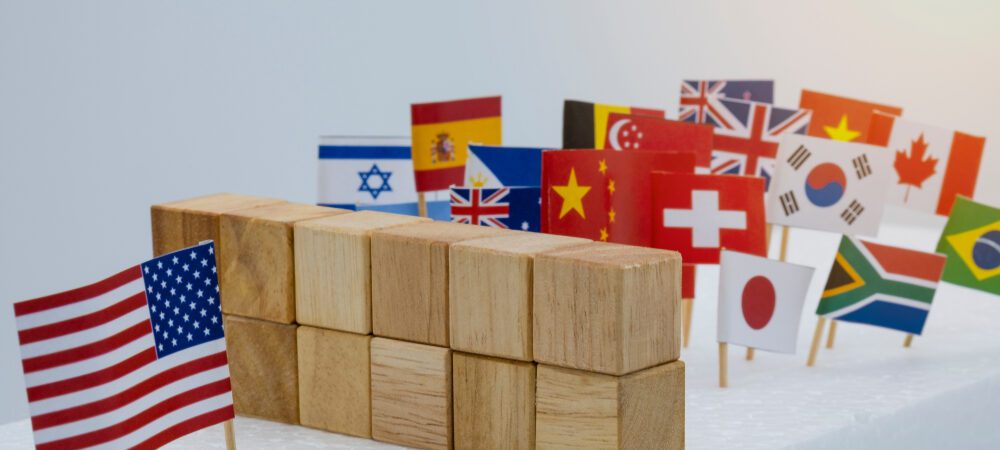Economists most often try to work with data (facts). For example, some have used data to estimate that certain tariffs proposed by former president Donald Trump would cost a typical US household more than $2,600 a year. Others have marshalled data to estimate that US economic growth would be slowed by Trump’s plans for tariffs and mass deportations of unauthorized immigrant workers and by his idea of allowing the president to have more influence over the Federal Reserve Board.
But there is no data to help evaluate some of Trump’s bigger but more vague tariff plans. Trump outlined his latest ideas in a recent appearance at the Economic Club of Chicago. He said that if he wins reelection, tariffs would be a major source of government revenue and would be used to:
- Retaliate against countries that are unfair traders.
- Rebalance trade with Europe and Japan, among others.
- Penalize American companies investing overseas if they plan to sell in the US market.
- Prevent would-be aggressor states from making war on their neighbors.
- Rebuild the American industrial base.
- Repair the US tax base.
- Cut the federal deficit.
Now here is where the estimating gets tough. The effects of Trump’s tariffs on the economy, on businesses, and on individual consumers and workers would literally be incalculable. Trump has told us of his tariffs’ many potential uses, but he left out details about how high they would be and how and when they would be applied. He has said that any tariff can be set at hundreds or a thousand percent. He clearly understands that if a tariff is high enough trade will cease, but that is a sacrifice that he sees as necessary to achieve his desired result. There is no upper limit. The assumption on which economists prepared their estimates was a 20 percent tariff on all imported goods, except goods from China that would bear a 60 percent tariff. But much more is being threatened by Trump than a blanket tariff at those levels.
There are those among Trump supporters, according to press reports, who say that the tariffs are mainly a negotiating ploy. But that is not what the former president is saying. If we are to take Trump at his word, there is no telling what tariffs there will be. A state of uncertainly may be good as a negotiating ploy in the private sector when buying or selling property, and sometimes maybe useful in extracting concessions from other governments in international negotiations, but widespread uncertainty in an economy would clearly be damaging to investment.
Nor are there clear answers as to what Trump would do with tariffs in a second term by looking to the extent of the legal authorities that Congress has given presidents.
The Constitution clearly gives the power over foreign commerce to the Congress, not the president. But the Congress has over time delegated much authority over tariffs to the president.
The president can retaliate against unreasonable and unjust (illegitimate) foreign practices. The courts could go along with additional retaliation but not tariffs on everything from everywhere. The issue is being litigated now.
If there were an international economic emergency, the courts could readily defer to the president to define when an emergency exists. There were 79 presidential declarations of national emergency through last year. It is not clear what the national emergency would be, but the president could find a reason for declaring one to exist, and the courts are deferential when it comes to the exercise of the president’s foreign affairs power.
There is the balance of payments authority for a broad tariff, but this is only good for 150 days before the Congress would have to act on granting further authority.
The president can act against countries that discriminate against US trade. The European Union, for example, treats a very large number of countries better than it does the United States, even if that discrimination is legitimate under the rules of the World Trading Organization (WTO), as the better treatment that these countries receive is through free trade agreements. Although the anti-discrimination authority granted to the US president has been on the books since 1930, it has never been used. But it could be, not for allowing Trump’s proposed tariffs on all imports but more selectively.
Trump has threatened to impose a 200 percent tariff on a single American company, John Deere, if the agricultural equipment maker moves some production to Mexico and tries to ship goods made there into the United States (which would be duty-free under the Trump-negotiated free trade agreement, the United States–Mexico–Canada Agreement). Trade experts know of no previous case in which a US president has imposed a tariff on the shipments from a single American company. There is no authority whatsoever vested in the president to apply tariffs in this manner. But the threat creates uncertainty for investment.
This recitation of delegated authorities does not take into account the possibility that Trump’s Republican Party gains a majority in both chambers of Congress, which would likely rubber stamp his actions. When and where and to what extent Trump’s tariffs would hit is anyone’s guess, and foreign retaliation is also not easily calculable. It is also hard to estimate the effects of trade wars on the global economy. This is a very high-risk experiment with no known limits.
The bottom line: The effect of the tariffs imposed in a second Trump presidency is incalculable.
The damage to the US economy would also be incalculable, except in a later damage assessment. By then it would be too late.
To read the blog as it was published by the Peterson Insitute for International Economics, click here.

